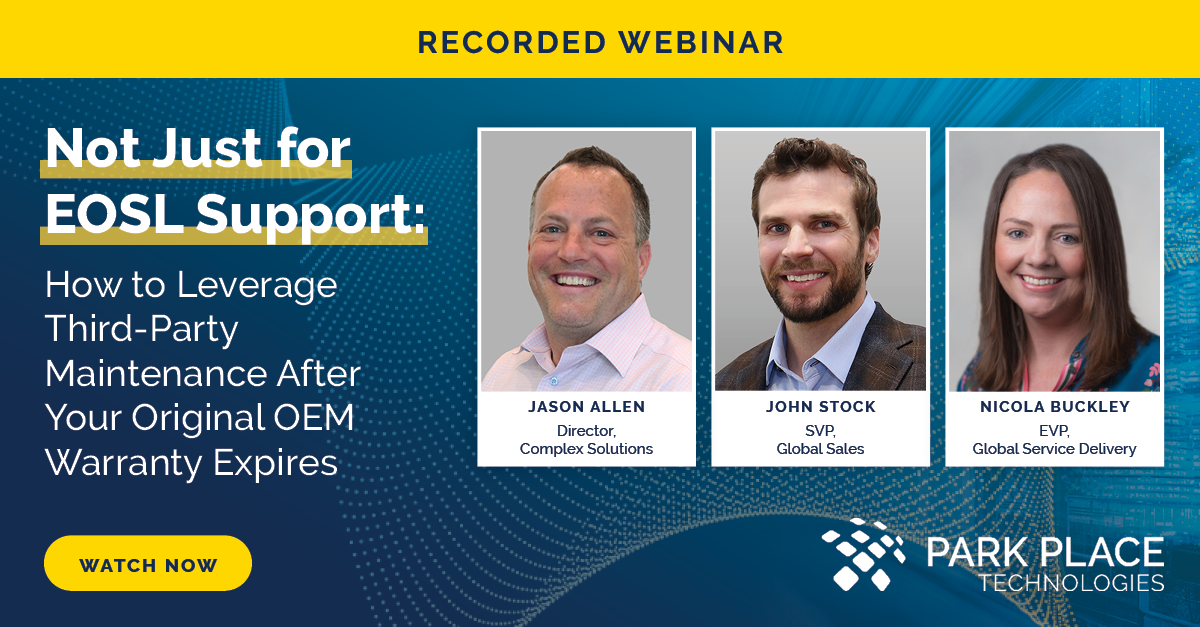What Is IT Asset Management? – ITAM Best Practices
Park Place Hardware Maintenance
Efficiently running a data center is no small feat. Five new storage arrays arrive today. Next month, ten servers are getting switched out with newer models, and the month after that, another ten. Hardware is decommissioned. Support warranties end, and new ones begin. Confusing, right? If your organization doesn’t have the proper procedures and software in place to accurately manage your most valuable assets, you’re putting your company at a significant disadvantage. Enter ITAM.
IT asset management (ITAM) is the process of ensuring an organization’s valuable IT assets are accounted for, deployed, maintained, upgraded, and disposed of when the time comes so as to maximize value while minimizing risk. More simply, it’s a set of ongoing business practices to ensure that IT assets, both tangible and intangible, within your organization are continually tracked and being utilized. To learn more about ITAM and its increasing importance within the data center, continue reading below.
What Is IT Asset Management?
Gartner characterizes IT asset management as “a set of processes for strategically tracking and managing the financial, physical, licensing, and contractual aspects of IT assets throughout their lifecycle”. Notice, this definition highlights 3 elements that are essential to realize the value of IT asset management:
- A focus on financial, contractual, and physical data
- Financial: purchase price, cost events, supplier, etc.
- Contractual: terms and conditions, software entitlement, support agreements, leases, warranties, etc.
- Physical: location, ownership, assignment, etc.
- The asset lifecycle
- And a process framework
Why Is ITAM Important?
Information technology is mission critical. Few businesses today could function without the IT assets – the hardware, software, network, and other technologies – that support business operations. Not only are IT assets numerous, they’re expensive to acquire, configure, and maintain. Moreover, IT assets are frequently moved, rapidly depreciate, and require constant update and replacement. Thus the objective of IT asset management is to ensure that this large volume of constantly churning, costly assets are effectively managed from beginning to end to achieve the highest possible ROI.
What Is an IT Asset?
Defined simply, IT assets include all the hardware, software, or information an organization values. The four main IT assets that are commonly managed include:
- Software
- Hardware
- Mobile Devices
- The Cloud
The IT Asset Lifecycle
IT assets have a finite period of use. So to maximize the value your organization can generate from them, the IT infrastructure lifecycle should be proactively managed. While each organization may define unique stages of that lifecycle, the stages generally include planning, procurement, deployment, maintenance, and retirement. But remember, effective IT asset management requires complete coverage of the entire IT hardware lifecycle.
Benefits of IT Asset Management
Once ITAM metrics are aligned with critical business/IT goals, you’ll see benefits such as:
- Increased efficiency in project management
- Better data security
- Improved software compliance
- Better communication between business units
- Faster incident resolution (improved MTTRS)
- Improved customer service through streamlined data availability
- Improving utilization and eliminating waste
- Cost reduction of IT assets through consistent review
- Streamlined budgeting process and decision-making through increased understanding of IT assets and their role in the company
IT Asset Management Best Practices
Given that IT infrastructure today spans outside of a centralized model (from data center, to edge, to cloud, to remote working devices), IT now faces an incredibly fluid, frequently mixed, and cloud-enabled landscape. Gone are the days of spreadsheets and information silos. Today’s ITAM needs to be agile, automated, and pervasive across the entire IT estate:
ITAM IS A PROCESS NOT A PROJECT – IT SHOULD BE ONGOING.
This will ensure that your firm does not abandon ITAM efforts following certain events like IT infrastructure audits (which tend to prompt an asset management process).
ITAM SHOULD BE PROACTIVE, NOT REACTIVE.
Rather than trying to quickly react to specific events, be constantly at the ready for anything that comes your way with a proper plan.
IMPLEMENT AN ITAM TEAM AND HAVE THEM RECEIVE FEEDBACK FROM OTHER BUSINESS UNITS.
Getting different teams from the firm involved in the implementation of an ITAM process will allow it to develop it over time, rather than simply being treated as an isolated task.
STICK TO THE PROVEN LIFECYCLE-BASED APPROACH.
Always remember that ITAM starts from when the purchase request is made and continues after an asset is no longer operationally active, extending to retirement and the IT asset disposal process.
AUTOMATE AS MUCH AS POSSIBLE.
The best way to do this is to use a license and/or asset management system. License management software makes this significantly easier, with features such as email alerts, customizable compliance reports, and file repositories.
TRACK CONTINUOUSLY TO AVOID OVER-DEPLOYMENT.
Many firms suffer from severe fines during audits because they have no proof of entitlement. Be sure to keep all license agreements and receipts in order to properly track compliance.
IT asset management is no longer optional. Unmanaged, the increasing complexity of IT assets will undoubtedly wreak chaos and lead to waste within your organization. But managed properly, IT can proactively push critical applications onto the most appropriate resources, working to save you time, money, and resources.
Get in touch with Park Place Technologies today to learn how our storage, network, and server management services can help your IT team excel.



